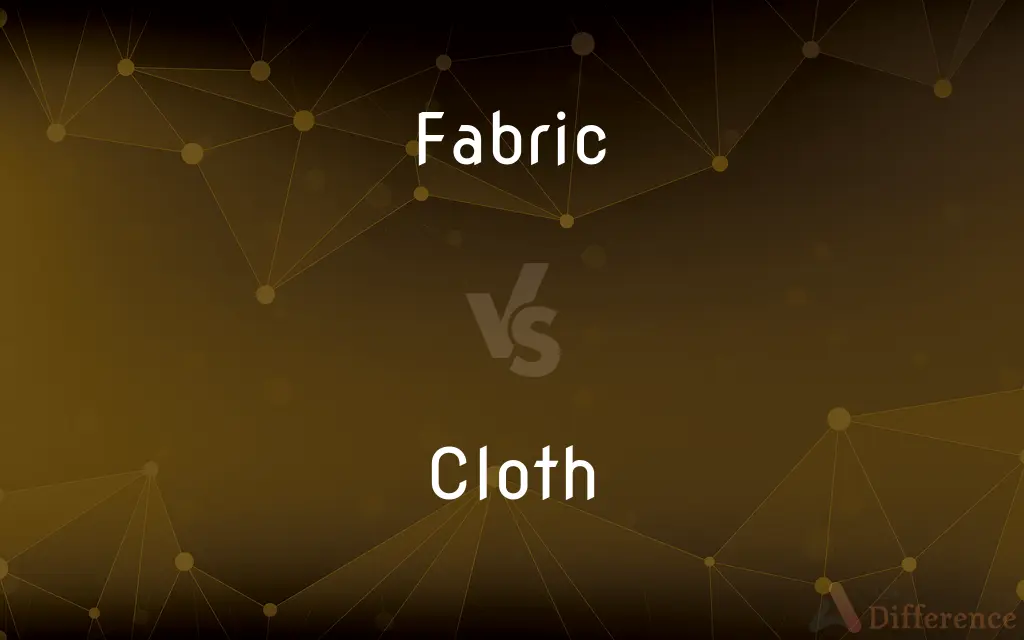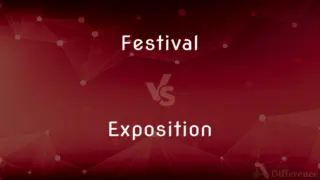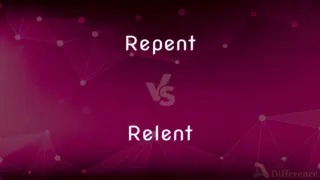Fabric vs. Cloth — What's the Difference?
By Maham Liaqat & Urooj Arif — Updated on March 15, 2024
Fabric is general term for any textile material made through weaving, knitting, spreading, crocheting, or bonding, used in production clothing. Cloth is a piece of fabric used for a particular purpose, often implying a finished finished piece of textile.

Difference Between Fabric and Cloth
Table of Contents
ADVERTISEMENT
Key Differences
Fabric encompasses a wide range of textile materials, including natural fibers like cotton, wool, silk, and synthetic fibers like polyester and nylon. It is the basic material used in the construction of various items, from clothing and accessories to home furnishings and industrial products. The term "fabric" highlights the material aspect, focusing on the composition, weave, texture, and pattern. On the other hand, cloth typically refers to a finished piece of fabric that has been designated for a specific use, such as a garment, cleaning rag, or decorative covering. The term "cloth" often conveys a sense of utility or purpose, emphasizing the functional aspect of the textile.
The production of fabric involves various processes, including spinning fibers into yarn, weaving or knitting yarn into textile material, and finishing processes like dyeing and printing to enhance its appearance and performance. Cloth, while made from fabric, is more about the end-use or the piece itself, suggesting that it has been cut, shaped, or tailored to fulfill a particular function or need.
In everyday language, "fabric" is a more inclusive term that can refer to the raw material available by the yard or meter, not yet transformed into a specific item. In contrast, "cloth" might be used more specifically to refer to items like tablecloths, dishcloths, or cloths used for cleaning, where the emphasis is on the item's role rather than its material composition.
While both fabric and cloth are integral to the textile industry, their distinction lies in perspective and usage. Fabric is the cornerstone of textile production, offering endless possibilities in terms of design, texture, and application. Cloth represents a more practical viewpoint, focusing on the tangible and often functional items made from fabric. This distinction, while subtle, is significant in contexts like textile manufacturing, retail, and fashion, where the precise understanding of these terms guides the creation and marketing of textile products.
Comparison Chart
Definition
A material made through weaving, knitting, or bonding that serves as the basis for textile production.
A finished piece of fabric that is used for a specific purpose, such as clothing or household items.
ADVERTISEMENT
Focus
Emphasizes the material properties, such as composition, texture, and pattern.
Focuses on the utility and function of the fabric, often implying a finished or tailored piece.
Usage
Broader term, can refer to the raw material sold by length for various applications.
More specific, often used to describe items like tablecloths, cleaning rags, or garments.
Production
Involves processes like spinning, weaving, dyeing, and finishing.
Implies that the fabric has been further processed or tailored into a usable item.
Examples
Cotton fabric, silk fabric, upholstery fabric.
Tablecloth, dishcloth, piece of clothing.
Compare with Definitions
Fabric
A material made by weaving, knitting, felting, or bonding fibers.
The designer chose a lightweight fabric for the summer collection.
Cloth
A finished piece of fabric used for a specific purpose.
She spread a beautiful lace cloth over the table for the party.
Fabric
Used to make a wide range of products.
The store offered a variety of fabrics for curtains and upholstery.
Cloth
Can be a generic term for fabric used in clothing.
The tailor recommended a sturdy cloth for the winter coat.
Fabric
Sold by length for various uses.
She bought three yards of fabric to sew a new dress.
Cloth
Often implies items related to clothing or household use.
He used a damp cloth to wipe the dust off the shelves.
Fabric
Can include natural and synthetic materials.
The fabric blend included both cotton and polyester for durability.
Cloth
Associated with practical and functional uses.
She kept a cloth in the kitchen for drying dishes.
Fabric
Involves various finishing processes.
The fabric underwent a special dyeing process to achieve its vibrant color.
Cloth
Refers to pieces cut or tailored from fabric.
The pattern required several different cloths to create a layered look.
Fabric
A cloth produced especially by knitting, weaving, or felting fibers.
Cloth
Woven or felted fabric made from wool, cotton, or a similar fibre
A cloth bag
A broad piece of pleated cloth
Fabric
The texture or quality of such cloth.
Cloth
The clergy; the clerical profession
Has he given up all ideas of the cloth?
Fabric
A complex underlying structure
Destroyed the very fabric of the ancient abbey during wartime bombing.
Needs to protect the fabric of civilized society.
Cloth
Fabric or material formed by weaving, knitting, pressing, or felting natural or synthetic fibers.
Fabric
A method or style of construction.
Cloth
A piece of fabric or material used for a specific purpose, as a tablecloth.
Fabric
A structural material, such as masonry or timber.
Cloth
Canvas.
Fabric
A physical structure; a building.
Cloth
A sail.
Fabric
An edifice or building.
Cloth
The characteristic attire of a profession, especially that of the clergy.
Fabric
(archaic) The act of constructing, construction, fabrication.
Cloth
The clergy
A man of the cloth.
Fabric
(archaic) The structure of anything, the manner in which the parts of a thing are united; workmanship, texture, make.
Cloth of a beautiful fabric
Cloth
A fabric, usually made of woven, knitted, or felted fibres or filaments, such as used in dressing, decorating, cleaning or other practical use.
Fabric
The physical material of a building.
This church dates back to the 11th century, though the great majority of its fabric is fifteenth century or later.
Cloth
Specifically, a tablecloth, especially as spread before a meal or removed afterwards.
Fabric
The framework underlying a structure.
The fabric of our lives
The fabric of the universe
Cloth
(countable) A piece of cloth used for a particular purpose.
Fabric
A material made of fibers, a textile or cloth.
Cotton fabric
Cloth
(metaphoric) Substance or essence; the whole of something complex.
Fabric
The texture of a cloth.
Cloth
(metaphoric) Appearance; seeming.
Fabric
(petrology) The appearance of crystalline grains in a rock.
Cloth
A form of attire that represents a particular profession or status.
Fabric
(computing) Interconnected nodes that look like a textile fabric when diagrammed.
The Internet is a fabric of computers connected by routers.
Cloth
(in idioms) Priesthood, clergy.
He is a respected man of the cloth.
Fabric
(transitive) To cover with fabric.
Cloth
A fabric made of fibrous material (or sometimes of wire, as in wire cloth); commonly, a woven fabric of cotton, woolen, or linen, adapted to be made into garments; specifically, woolen fabrics, as distinguished from all others.
Fabric
The structure of anything; the manner in which the parts of a thing are united; workmanship; texture; make; as cloth of a beautiful fabric.
Cloth
The dress; raiment. [Obs.] See Clothes.
I'll ne'er distust my God for cloth and bread.
Fabric
That which is fabricated
Anon out of the earth a fabric hugeRose like an exhalation.
Cloth
The distinctive dress of any profession, especially of the clergy; hence, the clerical profession.
Appeals were made to the priesthood. Would they tamely permit so gross an insult to be offered to their cloth?
The cloth, the clergy, are constituted for administering and for giving the best possible effect to . . . every axiom.
Fabric
Cloth of any kind that is woven or knit from fibers, whether vegetable, animal, or synthetic; manufactured cloth; as, silks or other fabrics; made of a fabric that is 50% cotton and 50% polyester.
Cloth
Artifact made by weaving or felting or knitting or crocheting natural or synthetic fibers;
The fabric in the curtains was light and semitraqnsparent
Woven cloth originated in Mesopotamia around 5000 BC
She measured off enough material for a dress
Fabric
The act of constructing; construction.
Tithe was received by the bishop, . . . for the fabric of the churches for the poor.
Fabric
Any system or structure consisting of connected parts; as, the fabric of the universe.
The whole vast fabric of society.
Fabric
To frame; to build; to construct.
Fabric
Artifact made by weaving or felting or knitting or crocheting natural or synthetic fibers;
The fabric in the curtains was light and semitraqnsparent
Woven cloth originated in Mesopotamia around 5000 BC
She measured off enough material for a dress
Fabric
The underlying structure;
Restoring the framework of the bombed building
It is part of the fabric of society
Common Curiosities
Is there a difference in quality between fabric and cloth?
Quality varies widely within both categories and depends on the material, weave, production process, and intended use rather than the terminology.
Can all fabrics be considered cloth?
While all cloths are made from fabric, not all fabrics are considered cloth until they are designated for a specific use or function.
How is fabric sold?
Fabric is typically sold by the yard or meter in stores, allowing customers to purchase the amount needed for their projects.
Is the term "fabric" more common in certain contexts?
Yes, "fabric" is more commonly used in fashion, design, and textile manufacturing, while "cloth" is more frequent in everyday language referring to household textiles or clothing.
Can the term "cloth" refer to multiple items?
Yes, "cloth" can refer to various items made from fabric, including clothing, table linens, and cleaning materials, emphasizing its utility.
Can fabric become cloth after purchase?
Yes, once fabric is tailored or designated for a specific use, such as becoming a piece of clothing or a tablecloth, it can be referred to as cloth.
Why is the distinction important?
The distinction is particularly relevant in textile and fashion industries for clarity in production, marketing, and retailing, guiding consumers and professionals in their choices and discussions.
Are certain materials only considered fabric and not cloth?
The distinction is not based on the material but on the use and state of the textile. Any material can be considered fabric, and it becomes cloth when used for a specific purpose.
How do I choose the right fabric or cloth for my project?
Consider the project's requirements, such as durability, flexibility, care instructions, and the desired appearance when selecting a fabric or cloth.
Are there any cultural differences in the use of these terms?
Usage can vary by region and culture, with some languages or dialects not differentiating as clearly between "fabric" and "cloth," or using different terms entirely.
Share Your Discovery

Previous Comparison
Festival vs. Exposition
Next Comparison
Repent vs. RelentAuthor Spotlight
Written by
Maham LiaqatCo-written by
Urooj ArifUrooj is a skilled content writer at Ask Difference, known for her exceptional ability to simplify complex topics into engaging and informative content. With a passion for research and a flair for clear, concise writing, she consistently delivers articles that resonate with our diverse audience.














































